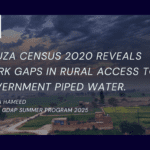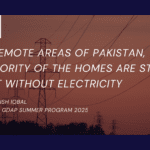
Mouza Census Reveals Stark Gaps in Rural Access to Government Piped Water
July 11, 2025
In Remote Areas of Pakistan, Majority of the Homes are Still Left Without Electricity
July 11, 2025By Atiqa Rani
Intern – GDAP Summer Program 2025
The Aga Khan University
The road to Europe is no longer open to everyone. Recent data from the Schengen Visa Issuance Statistics Dashboard shows a clear divide in visa approval among South Asian countries. While India has seen a strong recovery, Pakistan and Nepal are facing rising rejection rates.
Between the year 2019 and 2022, Schengen visa rejection trends for Germany shows us a compelling story. In the year 2019, the rejection rates were relatively lower for all three countries with Pakistan (25.77%), Nepal (16.81%) and India (10.07%). This situation was before the COVID-19, but the pandemic led to widespread visa restrictions and uncertainty.
In the year 2020, the pandemic led to a collapse in international travel. The rate of visa applications dropped with rejection rates increasing sharply. Pakistan saw its rate jumped to 41.92%, while Nepal’s increased to 24.53% and India’s to 16.06%.
From this situation India began to recover quickly, while Pakistan and Nepal continued to face the challenges. In the year 2022, India submitted over 76,000 applications and maintained a low rejection rate of 11.65% which highlights not just the recovery but also improved access. In contrast, Pakistan’s rejection rate increased again to 28.22% and Nepal’s to 42.64% which was the highest among the three countries.
Table Showing Rejection Rates:
|
Year |
Pakistan (%) | India (%) | Nepal (%) |
|
2019 |
25.77 |
10.07 |
16.81 |
|
2020 |
41.92 |
16.06 |
24.53 |
|
2021 |
24.45 |
14.97 |
27.65 |
| 2022 | 28.22 | 11.65 |
42.65 |
What makes this finding stand out is the increasing differences in how easily people from each country get visa. While India’s large applicant base enjoys rising approvals, Pakistan and Nepal are seeing an opposite trend of increasing rejections even though international travel has resumed. This point highlights deeper structural or diplomatic issues that affect the visa outcomes unevenly across the region.
Although the pandemic affected all countries, the post-COVID recovery in visa acceptance has not been equal. For applicants from Pakistan and Nepal, the data suggests that barriers to their mobility is higher, a trend that warrants further attention from both the public and policymakers.
For more infomration:
https://galluppakistandigitalanalytics.com/schengen-visa-issuance-statistics/
